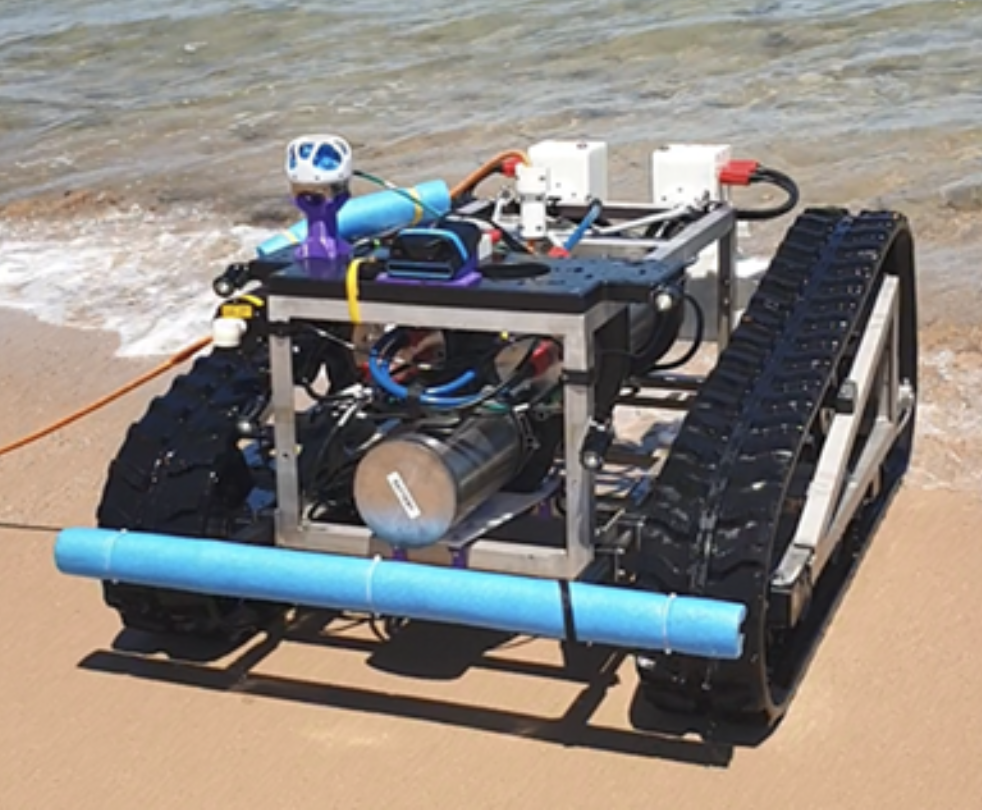
A mine-detecting underwater crawler developed by Flinders University was among newly developed technologies demonstrated as part of a national ‘Mine Counter-Measures in a Day’ project.
Teams from Thales Australia, Defence Science Technology Group, Flinders University, University of Sydney, University of Technology Sydney (UTS), Western Sydney University (WSU) and Australian firms Mission Systems and ineni Realtime descended on Christies Beach to demonstrate capabilities of a range of novel defence equipment.
‘Mine Counter-Measures (MCM) in a Day’ is a 3.5-year, $15 million program funded jointly by the Trusted Autonomous Defence CRC, Royal Australian Navy and Thales Underwater Systems Australia. The application is to use un-crewed underwater vehicles to look for mines, unexploded ordnance and other hazards at sea to reduce the threat they pose to our shipping and defence forces.
The project will design, develop, test and evaluate various teams of Autonomous Underwater Vehicle (AUV) swarms and Autonomous Surface/Subsurface Vessels (ASVs) to provide an autonomous mine clearance capability that operates in the amphibious zone close to shore.
The amphibious zone, also termed ‘the littoral environment,’ is notoriously complex to navigate when searching for underwater mines. The system must overcome tides, waves and currents and be equipped to work in a low visibility and low communications environment. The MCM In a Day project, will eventually seek to supplement current practices, that utilise the expertise of Navy Clearance Divers in exploratory Rapid Environmental Assessment (REA) of the area.
Flinders University’s Centre for Defence Engineering Research and Training (CDERT) Director, Professor Karl Sammut, says the Subsea Crawler vehicle was designed by a Flinders team and built in collaboration with German partner, iSeaMC with the aim of protecting lives. The CDERT team also includes Associate Professor Russell Brinkworth, Dr Phil Skelton and Dr Aaron Melville-Smith.
‘Most de-mining activities are usually conducted with specialised clearance vessels in deeper waters while divers are still required to investigate and clear threats in the relatively shallow and turbulent waters of the surf zone where the wave action and turbidity is significant, putting clearance divers at risk. This project is specifically targeted at addressing this problem and reducing risk to human life,’ Professor Sammut says.
Thales is the lead organisation managing the collaboration between the partners. Flinders is working on the Subsea Crawler, University of Sydney is developing a hovering autonomous underwater vehicle, Mission Systems is creating a small surface vehicle to operate in the surf zone, UTS is developing the mission planning software for the swarm of vehicles, and ienei Realtime and WSU experts are bringing together the Human-Machine Interface software for operators to observe and manage the team of vehicles remotely.

‘It’s been an excellent collaboration that demonstrates what can truly be achieved when you bring industry and academia together with defence partners to work on a large project. The Thales team have done an outstanding job in working with all the partners.
‘During October and November, all the partners met up in person in our Maritime Lab at Flinders University to integrate their respective systems together culminating in combined trials at Christies Beach in late November. Followup tests are planned in 2023.
‘This project has built on our expertise in maritime autonomy, and it’s given us an invaluable opportunity to work with other excellent partners,’ Professor Sammut says.
John Best, Thales Australia’s Chief Technical Officer, was present at the demonstration, and noted the step-change this capability will provide to the Australian Navy.
‘This project will utilise technology to transform high risk, and labour-intensive activities and accelerate amphibious zone mine clearance. By reducing the time it takes to clear a landing zone, while also gathering and analysing mission critical environmental data, personnel safety will be enhanced, as will the gathering of operational intelligence,’ he says.
Richard Price, Defence SA Chief Executive, says the project is a great example of the benefits that collaboration brings.
‘Collaboration is vital for innovation and the development of this cutting-edge defence technology is a great example of what can be achieved when universities and industry work closely with Defence to co-design solutions to increasingly complex challenges,’ he says.
‘South Australia has a long history of success in defence research and development and this latest demonstration showcases our strength as a critical testbed for defence technologies.’
This project is a true reflection of collaboration between defence, academia and industry as well as a demonstration of sovereign capability. The majority of the equipment has been developed in country or brought in on specification and then modified to support the unique Australian conditions. There is total sovereign control over all software and hardware elements of the project.
The demonstration at Christies Beach marks an important milestone for the project which is in its second year, with further development and demonstration work to continue during 2023 until project completion early 2024.

